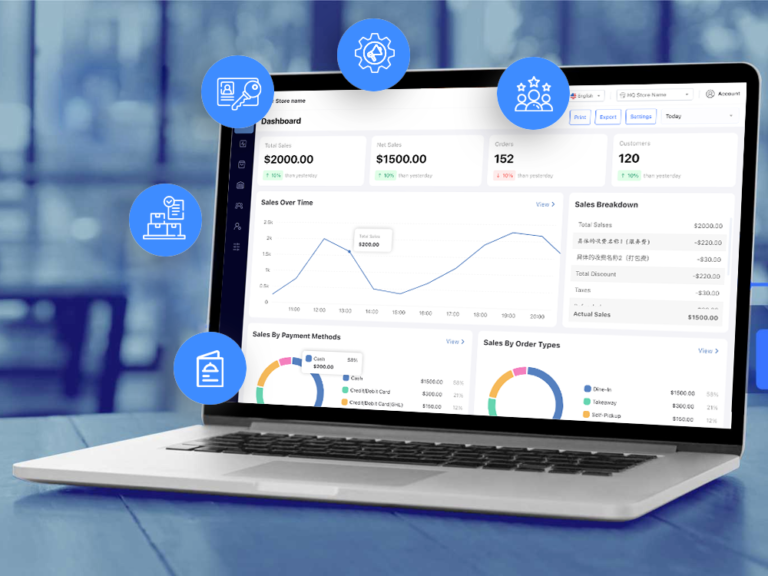Table of Contents
The restaurant industry is on the cusp of a technological revolution, and Point of Sale (POS) systems are at the heart of this transformation. As we approach 2025, advancements in artificial intelligence (AI) and automation are redefining how restaurants operate, from streamlining operations to enhancing customer experiences. Cloud-based POS systems, like those offered by OrderPin, are paving the way for these innovations, enabling restaurants to stay competitive in a fast-evolving market. This article explores the top AI and automation trends shaping the future of restaurant POS systems and how businesses can prepare for what’s next.
Why AI and Automation Matter for Restaurant POS
Modern restaurants face intense pressure to deliver fast service, personalized experiences, and operational efficiency while managing rising costs. Traditional POS systems, limited to basic transactions and reporting, are no longer sufficient. AI and automation, integrated into cloud-based POS platforms, offer solutions that:
Optimize Operations: Automate repetitive tasks like inventory tracking and order routing.
Enhance Decision-Making: Use AI to predict demand and personalize menus.
Improve Customer Satisfaction: Deliver faster, tailored experiences through smart technology.
OrderPin’s AWS-based POS, for example, is designed to integrate emerging technologies, ensuring restaurants can adapt to these trends without overhauling their systems. Let’s dive into the key trends to watch in 2025.
Top AI and Automation Trends for Restaurant POS in 2025
1. AI-Powered Predictive Analytics
AI is transforming how restaurants use data. Predictive analytics, powered by machine learning, allows POS systems to forecast demand, optimize inventory, and personalize customer interactions. In 2025, expect POS systems to:
Predict Sales Trends: Analyze historical data to anticipate busy periods, enabling better staffing and inventory planning.
Optimize Inventory: Suggest reorder quantities based on sales patterns, reducing waste and stockouts.
Personalize Offers: Recommend upsell items or loyalty discounts based on customer purchase history.
For instance, a café using OrderPin’s POS could leverage AI to predict a surge in coffee orders on Monday mornings, ensuring sufficient stock and staff. This reduces wait times and boosts revenue through targeted promotions.
Impact: Predictive analytics can cut inventory waste by up to 20% and increase sales through personalized marketing.
2. Automated Order Routing and Kitchen Integration
Automation is streamlining kitchen operations by connecting POS systems directly to kitchen workflows. In 2025, advanced POS platforms will:
Route Orders Automatically: Send orders to specific kitchen stations (e.g., grill, bar) based on item type, reducing manual coordination.
Prioritize Orders: Use AI to sequence orders for optimal preparation time, especially during peak hours.
Integrate with Smart Appliances: Sync with IoT-enabled ovens or fryers that notify the POS when food is ready.
OrderPin’s POS already supports seamless order routing, and its roadmap includes IoT integration, allowing kitchens to operate with minimal human intervention. A fast-casual restaurant using this technology could reduce order fulfillment time by 30%, enhancing customer satisfaction.
Impact: Automated routing minimizes errors and speeds up service, increasing table turnover.
3. Voice-Activated Ordering and Staff Assistance
Voice technology is gaining traction in restaurants, driven by the popularity of voice assistants like Alexa and Siri. By 2025, POS systems will incorporate voice-activated features to:
Accept Customer Orders: Allow diners to place orders via voice-enabled kiosks or tableside devices.
Assist Staff: Enable servers to query the POS hands-free (e.g., “What’s the status of Table 5’s order?”).
Reduce Training Time: Use natural language processing to guide new staff through POS functions.
OrderPin is exploring voice integration to complement its user-friendly interface, which already boasts a 5-minute learning curve. Imagine a server using voice commands to check inventory during a busy shift, freeing them to focus on guests.
Impact: Voice ordering can reduce order entry time by 15% and improve staff efficiency.
4. AI-Driven Customer Experience Enhancements
Personalization is a top priority for restaurants, and AI is making it easier to deliver tailored experiences. In 2025, POS systems will use AI to:
Customize Menus: Display dynamic menus based on customer preferences or time of day (e.g., breakfast vs. dinner items).
Recommend Add-Ons: Suggest complementary items during QR code or online ordering, increasing average order value.
Enhance Loyalty Programs: Automatically reward frequent diners with personalized offers tracked via the POS.
OrderPin’s omnichannel POS already supports QR code ordering and loyalty tracking, with plans to integrate AI for smarter recommendations. A fine-dining restaurant could use this to suggest wine pairings, boosting sales by 10%.
Impact: AI-driven personalization can increase customer retention and upsell revenue.
5. Enhanced Security with AI Fraud Detection
As digital payments grow, so do security risks. AI-powered POS systems in 2025 will strengthen security through:
Fraud Detection: Identify suspicious transactions (e.g., unusual payment patterns) in real time.
Biometric Authentication: Support facial recognition or fingerprint scanning for staff logins or high-value transactions.
Encrypted Data: Use AI to monitor and protect customer data stored in the cloud.
OrderPin’s AWS-based platform prioritizes security with end-to-end encryption and is poised to adopt AI fraud detection, ensuring restaurants and customers are protected. This is critical for building trust in an era of increasing cyberattacks.
Impact: Enhanced security reduces fraud-related losses and builds customer confidence.

Case Study: A Restaurant Embracing AI and Automation
Take the example of Urban Bites, a multi-location restaurant chain in Chicago. Urban Bites adopted OrderPin’s cloud-based POS to streamline operations across its three locations. In 2024, they began testing OrderPin’s AI-driven features, including:
Predictive Inventory: AI forecasted ingredient needs, reducing food waste by 15%.
Automated Order Routing: Orders were sent directly to kitchen stations, cutting preparation time by 25%.
Personalized Offers: The POS suggested add-ons via QR code menus, increasing average order value by 12%.
By leveraging these features, Urban Bites improved efficiency, reduced costs, and saw a 20% rise in customer satisfaction scores. As OrderPin rolls out more AI and automation capabilities in 2025, Urban Bites is well-positioned to scale further.
How to Future-Proof Your Restaurant POS
Adopting a forward-thinking POS system is essential to stay ahead in 2025. Here’s how restaurants can prepare:
Choose a Cloud-Based Platform: Opt for a scalable, cloud-based POS like OrderPin, built on AWS for reliability and future integrations.
Prioritize AI Compatibility: Select a system with a roadmap for AI and automation features, such as predictive analytics or voice ordering.
Integrate Omnichannel Ordering: Ensure your POS supports tableside, online, QR code, and third-party orders for a seamless experience.
Train Staff Efficiently: Use a POS with a short learning curve (like OrderPin’s 5-minute onboarding) to minimize disruption.
Monitor Emerging Trends: Stay informed about AI and IoT developments to capitalize on new opportunities.
Challenges to Consider
While AI and automation offer immense benefits, restaurants should be aware of potential challenges:
Cost: Advanced features may require higher subscription tiers, though OrderPin’s affordable pricing mitigates this.
Learning Curve: Staff may need training for new features, but intuitive systems like OrderPin reduce this barrier.
Data Privacy: Ensure your POS complies with regulations like GDPR or CCPA, as OrderPin does with its secure AWS infrastructure.
By choosing a trusted provider and planning for these challenges, restaurants can maximize the benefits of AI and automation.
Why OrderPin Is Ready for 2025
OrderPin’s cloud-based POS is designed with the future in mind. Built on AWS, it offers:
Scalability: Supports single locations or multi-unit chains with ease.
Omnichannel Integration: Syncs orders from all channels, including QR codes and third-party platforms.
Innovation Roadmap: Plans for AI analytics, voice ordering, and IoT integration in 2025.
User-Friendly Design: A 5-minute learning curve and multilingual support for diverse teams.
Whether you’re a small café or a growing chain, OrderPin empowers you to embrace the future of restaurant technology without complexity or high costs.
Conclusion
The future of restaurant POS systems is bright, with AI and automation driving unprecedented efficiency and customer satisfaction. From predictive analytics to voice-activated ordering, these technologies are transforming how restaurants operate, and 2025 will be a pivotal year for adoption. By investing in a cloud-based POS like OrderPin, restaurants can stay ahead of the curve, reduce costs, and delight customers with personalized, seamless experiences.


